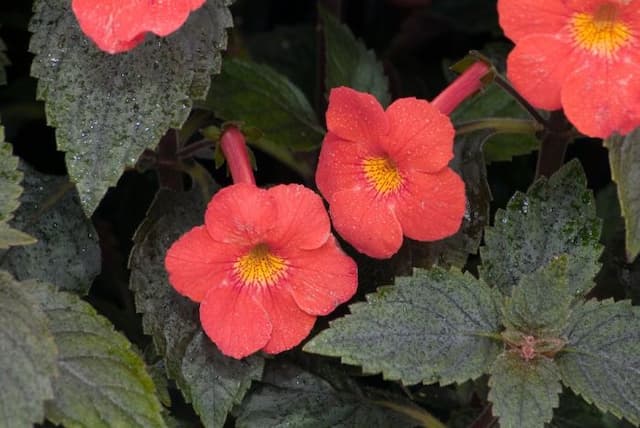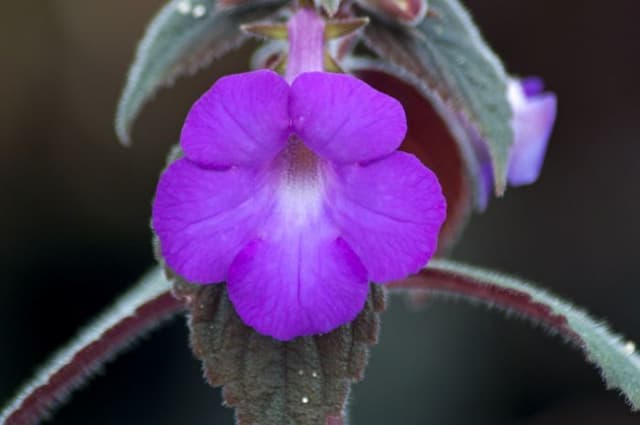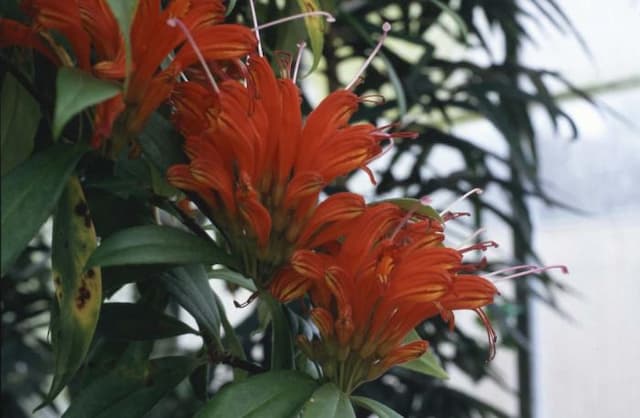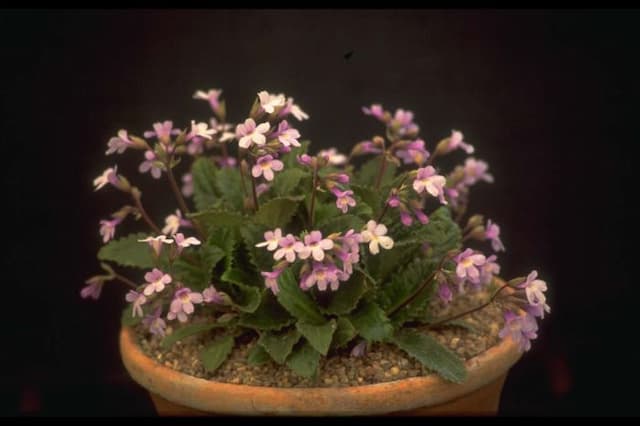Cape Primrose Streptocarpus 'Amy'

ABOUT
Streptocarpus 'Amy', commonly known as Cape primrose, features a striking display of velvety foliage and vibrant flowers. The leaves of this plant are typically lush and elongated with a soft, almost furry surface that invites touch. They are deep green in color and can have a slightly wrinkled texture, which adds depth to their appearance. The flowers of Cape primrose are its most distinguishing feature, and in the case of 'Amy', they bloom in a charming shade that can range from a delicate pink to a more robust rosy hue. Each blossom comprises of five rounded petals, with a slightly tubular base, resembling small trumpets heralding the arrival of spring. The throat of the flowers often showcases a contrasting color, complete with delicate veining or speckling which enhances their ornamental appeal. These blooms are held aloft on slender stems that rise above the foliage, elegantly presenting the flowers and making them a focal point of the plant’s visual display. The juxtaposition of the soft yet striking leaves against the gentle beauty of the flowers provides a lush and romantic aesthetic, perfect for brightening up indoor spaces or shaded garden areas.
About this plant
 Names
NamesFamily
Gesneriaceae.
Synonyms
Cape Primrose, African Violet Cousin.
Common names
Streptocarpus 'Amy'.
 Toxicity
ToxicityTo humans
Cape primrose (Streptocarpus 'Amy') is not known to be toxic to humans. There are no reported symptoms of poisoning from ingesting this plant.
To pets
Cape primrose (Streptocarpus 'Amy') is also not known to be toxic to pets. It is not expected to cause any symptoms of poisoning if ingested by animals such as cats and dogs.
 Characteristics
CharacteristicsLife cycle
Perennials
Foliage type
Evergreen
Color of leaves
Green
Flower color
Varies
Height
1 foot (30 cm)
Spread
1 foot (30 cm)
Plant type
Herb
Hardiness zones
10
Native area
Africa
Benefits
 General Benefits
General Benefits- Low Maintenance: Streptocarpus, commonly known as Cape Primrose, typically requires minimal care, making it a convenient choice for both beginners and experienced gardeners alike.
- Long Blooming Period: Cape Primrose is known for its lengthy blooming cycle, often providing a display of flowers for the majority of the year.
- Variety of Colors: Streptocarpus 'Amy' offers a range of vibrant colors that can add beauty and interest to any home or garden space.
- Compact Size: This plant's compact growth habit makes it suitable for small spaces such as tabletops, windowsills, and limited-area gardens.
- Versatility: Cape Primrose is versatile and can be grown both indoors as a houseplant and outdoors in suitable climates, offering flexibility for plant placement.
- Attracts Pollinators: When grown outdoors, the bright flowers can attract beneficial pollinators like butterflies and hummingbirds to the garden.
 Medical Properties
Medical PropertiesThis plant is not used for medical purposes.
 Air-purifying Qualities
Air-purifying QualitiesThis plant is not specifically known for air purifying qualities.
 Other Uses
Other Uses- Cape Primrose can be used in fairy gardens or miniature landscaping projects due to their small size and appealing flowers, making them perfect for adding a touch of color and whimsy to tiny thematic gardens.
- Cape Primrose contributes to educational projects such as school plant biology studies, where children can learn about plant growth and flowering by observing and caring for a living plant.
- These plants serve as living art when creatively arranged in a series of pot planters on walls or shelves, providing a varying display of color and form throughout their blooming season.
- Cape Primrose can be a subject for botanical illustration and photography due to their vibrant colors and intricate floral patterns, allowing artists and photographers to capture their beauty.
- Individuals practice their propagation skills on Cape Primrose because it can be relatively easy to propagate from leaf cuttings, making it an educational experience for gardening enthusiasts.
- The blossoms of Cape Primrose can sometimes be used in crafting, such as pressing flowers for bookmarks or cards, due to their varied and vivid coloration.
- They can act as natural indicators of a room's humidity levels; if the plant starts to wilt, it may suggest the room is too dry, and misting or a humidifier might be necessary.
- As a companion plant in a greenhouse setting, Cape Primrose can provide color and contrast, enhancing the overall aesthetics and diversity of the plant collection.
- In a sensory garden, the soft foliage and colorful flowers of Cape Primrose can offer a tactile and visual experience, making it accessible and enjoyable for people with sensory processing disorders.
- The diversity of Cape Primrose's bloom colors can be used to teach concepts of genetics and inheritance in biology classes, illustrating how different traits are expressed in offspring.
Interesting Facts
 Feng Shui
Feng ShuiThe Cape Primrose is not used in Feng Shui practice.
 Zodiac Sign Compitability
Zodiac Sign CompitabilityThe Cape Primrose is not used in astrology practice.
 Plant Symbolism
Plant Symbolism- Persistence: The Cape primrose, as Streptocarpus 'Amy' is commonly known, symbolizes persistence due to its ability to flourish with minimal care and continue blooming in proper growing conditions.
- Hope: With its delicate flowers that continuously emerge, the Cape primrose is often seen as a symbol of hope and an encouraging presence that beauty can persist in the face of challenges.
- Endurance: Representative of endurance, the Cape primrose sustains bloom over a long period, reflecting the quality of withstanding difficult conditions.
- Vitality: The healthy growth and vibrant flowers of Streptocarpus 'Amy' exude vitality, signifying liveliness and energy.
 Water
WaterWater Cape Primrose regularly, ideally when the top inch of soil becomes dry to the touch. This translates to roughly every 7-10 days, depending on environmental conditions but avoid allowing the plant to sit in water. Use room temperature water and aim to apply it directly to the soil, not the foliage, to prevent leaf rot. On average, Cape Primrose will require approximately 8-16 ounces of water per watering, but this may vary with pot size and indoor conditions.
 Light
LightCape Primrose thrives in bright, indirect light, so a spot near an east or north-facing window is ideal. Direct sunlight should be avoided as it can scorch the leaves, while too little light can cause the plant to become leggy.
 Temperature
TemperatureFor Cape Primrose, the preferable temperature range is between 60 and 75 degrees Fahrenheit. They can survive in temperatures as low as 50 degrees Fahrenheit and as high as 90 degrees Fahrenheit, but the ideal range ensures healthy growth and blooming.
 Pruning
PruningPrune Cape Primrose to maintain shape and encourage bushier growth, usually done after the main blooming cycle. Remove faded flowers and yellowing leaves to promote new blooms. The best time for pruning is typically late winter or early spring.
 Cleaning
CleaningAs needed
 Soil
SoilThe African Violet, commonly referred to as Streptocarpus 'Amy', thrives in light, porous, and well-draining soil with a pH around 6.0-6.5. A mix of peat moss, perlite, and vermiculite in equal parts is often recommended for the best growth.
 Repotting
RepottingAfrican Violets like Streptocarpus 'Amy' should be repotted every 6 to 12 months to refresh the soil and provide room for growth. It's best to repot when the plant begins to outgrow its current container.
 Humidity & Misting
Humidity & MistingAfrican Violets such as Streptocarpus 'Amy' prefer moderate to high humidity levels, ideally around 50-60%. These plants will benefit from increased humidity, but it's important to avoid wet foliage.
 Suitable locations
Suitable locationsIndoor
Provide bright, indirect light, and keep the soil moist.
Outdoor
Best in warm weather, shaded; avoid direct sunlight.
Hardiness zone
11-12 USDA
 Life cycle
Life cycleStreptocarpus 'Amy', also known as Cape Primrose, begins its life cycle when seeds are sown in well-draining soil mix, usually in a warm, bright, indirect light environment. Germination occurs within two to three weeks, after which the seedlings gradually develop into vegetative plants with characteristic rosettes of furry, elongated leaves. The vegetative stage can last several months as the plant matures and builds energy reserves. Cape Primrose typically blossoms in the spring and summer, producing vibrant trumpet-shaped flowers that emerge from the base of the leaves. The flowering stage can be prolonged with proper care, including regular feeding and deadheading of spent flowers. After flowering, if conditions remain favorable, Streptocarpus 'Amy' can continuously produce new flowers while maintaining its vegetative state, potentially living for several years as a perennial indoors.
 Propogation
PropogationPropogation time
Spring-Early Summer
Propogation: Streptocarpus 'Amy', commonly known as Cape Primrose, is best propagated through leaf cuttings, a method often employed by growers for its simplicity and effectiveness. The ideal time for propagation is during the plant's active growing season, which is typically late spring to early summer. To propagate by leaf cuttings, select a healthy, mature leaf and cut it into horizontal strips about 2 to 3 inches (5 to 7.6 cm) long. Each strip should contain a vein. These strips are then placed vein-side down in moist potting mix. It's crucial to maintain a humid environment, which can be achieved by covering the pot with a clear plastic bag or placing it in a mini-greenhouse. In several weeks, small plantlets will emerge from the veins, and these can be separated and potted individually once they have grown large enough to handle.









